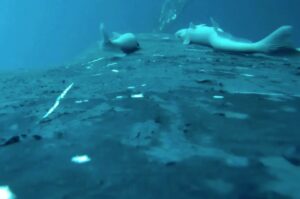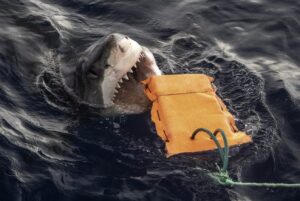On May 31, Cyril Derreumaux dipped his paddle in the Pacific and began his 4,450km solo kayak from San Francisco to Hawaii. The 44-year-old hopes to complete the journey in 70 days.
His custom-made kayak Valentine — named after his sister –- includes an enlarged watertight aft cockpit for sleeping and storage of some of his 140 kilograms of equipment and supplies. This makes his experience quite different from the iconic paddle that Ed Gillet did in 1987, using an off-the-shelf sea kayak. Gillet, the only person to kayak from the U.S. to Hawaii, was the inspiration for Derreumaux’s project.
His first day went smoothly. A number of whales breached nearby in the near-perfect conditions, and he crossed paths with rowers starting the Great Pacific Race, also to Hawaii.
In 2016, Derreumaux and his three teammates set a Guinness record in that event for the fastest crossing: 39 days, 9 hours and 56 minutes. Until now, he has cited that row as his biggest adventure to date. If he completes the paddle, he will be the only person to have both kayaked and rowed the route.
Good first day, then rough weather
Since that idyllic first day of paddling, winds and seas have worsened. On his second day, seasickness slowed his pace. On day one, he covered 57km. This fell to 48km on day two, still a fair pace.

Derreumaux began his kayak surrounded by friends and family who took to the water to wave him off. Photo: solokayaktohawaii.com
He faced even rougher conditions and a bumpier ride on the third day. It forced him to deploy his sea anchor and hunker down inside the Valentine.
“Waves are crashing on top of Valentine, but I feel safe,” he said via his satellite device-cum-live tracker. “I was able to make west with side waves on my right side. Swell increased size progressively as the wind picked up too. White[caps] appeared so I decided to stop for the day. I paddled non-stop for seven hours and am super tired. Still a bit weak from yesterday’s seasickness so can’t eat much. Forcing myself. Wind is increasing tonight and stronger and stronger until Saturday.”

The rowers in the Great Pacific Race are having to deal with the same strong northern winds as Derreumaux.
Conditions remained difficult on the fourth day as well, so he remained in the cabin. He expects to have to stay there until at least Tuesday. “Mentally feel good”, his latest message says.

Leaving San Francisco in ideal weather. Photo: solokayaktohawaii.com
Derreumaux has prepared for this expedition for three years, including several months of unexpected extra training, when he couldn’t begin on schedule because of COVID.
Unlike his inspiration, Ed Gillet, who set out with very little and succeeded — even survived — miraculously, Derreumaux has technology and backups for everything. “Even if everything fails electrically, I have manual back-ups,” he says. “I have two propulsion systems, two battery systems, solar panels, two watermaker systems, three tracker systems, and of course a lifeline still attached to the boat. I am also in contact by satellite phone with my team.”






